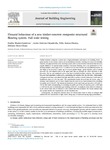Mostrar o rexistro simple do ítem
Flexural behaviour of a new timber-concrete composite structural flooring system. Full scale testing
| dc.contributor.author | Martín-Gutiérrez, Emilio | |
| dc.contributor.author | Estévez-Cimadevila, Javier | |
| dc.contributor.author | Suárez-Riestra, Félix | |
| dc.contributor.author | Otero-Chans, Dolores | |
| dc.date.accessioned | 2023-01-02T10:23:09Z | |
| dc.date.available | 2023-01-02T10:23:09Z | |
| dc.date.issued | 2023-04-01 | |
| dc.identifier.citation | MARTÍN-GUTIÉRREZ, Emilio, et al. Flexural behaviour of a new timber-concrete composite structural flooring system. Full scale testing. Journal of Building Engineering, 2023, vol. 64, p. 105606. | es_ES |
| dc.identifier.issn | 2352-7102 | |
| dc.identifier.uri | http://hdl.handle.net/2183/32275 | |
| dc.description.abstract | [Abstract] Timber-concrete composite systems are a high-performance alternative for building floors, of great interest in the current context of environmental concerns. Looking for a more eco-friendly solution, the paper presents a new flooring system with a wood-concrete connection that does not require adhesives or special metal elements. Four-point bending tests were performed on TCC flooring samples with a span of 6.0, 7.2 and 8.4 m. Its cross section was a prefabricated piece in the shape of an inverted T made up of a lower glulam flange, glued together with a central plywood rib with aligned holes in its upper part that go through the entire thickness of the plywood. The set was completed with a top layer of poured-in-place concrete. The connection between both materials is achieved by penetrating the concrete into the rib holes. Additionally, corrugated steel bars were placed through said holes to achieve ductile behaviour. In all cases, a slenderness ratio of L/24 was used. The experimental results showed that the lowest value of ultimate load obtained was 4.3 times higher than the total service load estimated for a building for public use (9 kN/m2). The maximum deflection of the total load was between L/573 and L/709 for the loads corresponding to a building for public use (9 kN/m2) and between L/1069 and L/1340 for the case of residential type building (5 kN/m2). An analysis of the effects of vibrations in the service limit state in relation to user comfort has been included. The results indicate that the system satisfies the requirements for the intended uses. Consequently, the proposed solution shows its effectiveness both in terms of strength and stiffness for the construction of light floors, being easy to build and having high performance. | es_ES |
| dc.description.sponsorship | Ministerio de Ciencia e Innovación; PID2019-107859RB-I00 | es_ES |
| dc.language.iso | eng | es_ES |
| dc.publisher | Elsevier Ltd | es_ES |
| dc.relation.uri | https://doi.org/10.1016/j.jobe.2022.105606 | es_ES |
| dc.rights | Atribución-NoComercial-SinDerivadas 3.0 España | es_ES |
| dc.rights.uri | http://creativecommons.org/licenses/by-nc-nd/3.0/es/ | * |
| dc.subject | Flexural behaviour | es_ES |
| dc.subject | Four-point bending test | es_ES |
| dc.subject | Timber flooring systems | es_ES |
| dc.subject | Timber-concrete composite | es_ES |
| dc.title | Flexural behaviour of a new timber-concrete composite structural flooring system. Full scale testing | es_ES |
| dc.type | info:eu-repo/semantics/article | es_ES |
| dc.rights.access | info:eu-repo/semantics/openAccess | es_ES |
| UDC.journalTitle | Journal of Building Engineering | es_ES |
| UDC.volume | 64 | es_ES |
Ficheiros no ítem
Este ítem aparece na(s) seguinte(s) colección(s)
-
GI-GEA - Artigos [68]






